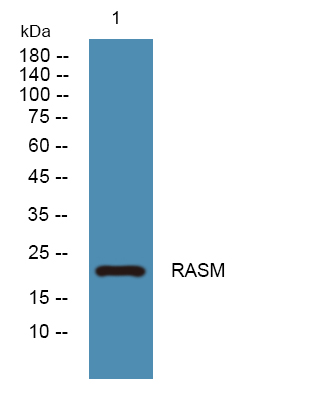RASM Polyclonal Antibody
- Catalog No.:YN2100
- Applications:WB;ELISA
- Reactivity:Human;Rat;Mouse
- Target:
- RASM
- Fields:
- >>MAPK signaling pathway;>>Ras signaling pathway;>>Rap1 signaling pathway;>>Phospholipase D signaling pathway;>>Mitophagy - animal;>>Autophagy - animal;>>Cellular senescence;>>Apelin signaling pathway;>>C-type lectin receptor signaling pathway;>>Regulation of actin cytoskeleton;>>Proteoglycans in cancer
- Gene Name:
- MRAS RRAS3
- Protein Name:
- Ras-related protein M-Ras (Ras-related protein R-Ras3)
- Human Gene Id:
- 22808
- Human Swiss Prot No:
- O14807
- Mouse Swiss Prot No:
- O08989
- Rat Swiss Prot No:
- P97538
- Immunogen:
- Synthesized peptide derived from part region of human protein
- Specificity:
- RASM Polyclonal Antibody detects endogenous levels of protein.
- Formulation:
- Liquid in PBS containing 50% glycerol, and 0.02% sodium azide.
- Source:
- Polyclonal, Rabbit,IgG
- Dilution:
- WB 1:500-2000 ELISA 1:5000-20000
- Purification:
- The antibody was affinity-purified from rabbit antiserum by affinity-chromatography using epitope-specific immunogen.
- Concentration:
- 1 mg/ml
- Storage Stability:
- -15°C to -25°C/1 year(Do not lower than -25°C)
- Observed Band(KD):
- 22kD
- Background:
- This gene encodes a member of the Ras family of small GTPases. These membrane-associated proteins function as signal transducers in multiple processes including cell growth and differentiation, and dysregulation of Ras signaling has been associated with many types of cancer. The encoded protein may play a role in the tumor necrosis factor-alpha and MAP kinase signaling pathways. Alternatively spliced transcript variants encoding multiple isoforms have been observed for this gene. [provided by RefSeq, Nov 2011],
- Function:
- function:May serve as an important signal transducer for a novel upstream stimuli in controlling cell proliferation. Weakly activates the MAP kinase pathway.,induction:By interleukin-9, but not by IL-2 or IL-4.,similarity:Belongs to the small GTPase superfamily. Ras family.,subunit:Interacts with RGL3.,tissue specificity:Expression highly restricted to the brain and heart.,
- Subcellular Location:
- Cell membrane ; Lipid-anchor ; Cytoplasmic side .
- Expression:
- Expression highly restricted to the brain and heart.
- June 19-2018
- WESTERN IMMUNOBLOTTING PROTOCOL
- June 19-2018
- IMMUNOHISTOCHEMISTRY-PARAFFIN PROTOCOL
- June 19-2018
- IMMUNOFLUORESCENCE PROTOCOL
- September 08-2020
- FLOW-CYTOMEYRT-PROTOCOL
- May 20-2022
- Cell-Based ELISA│解您多样本WB检测之困扰
- July 13-2018
- CELL-BASED-ELISA-PROTOCOL-FOR-ACETYL-PROTEIN
- July 13-2018
- CELL-BASED-ELISA-PROTOCOL-FOR-PHOSPHO-PROTEIN
- July 13-2018
- Antibody-FAQs
- Products Images

- Western blot analysis of lysates from Jurkat cells, primary antibody was diluted at 1:1000, 4°over night



